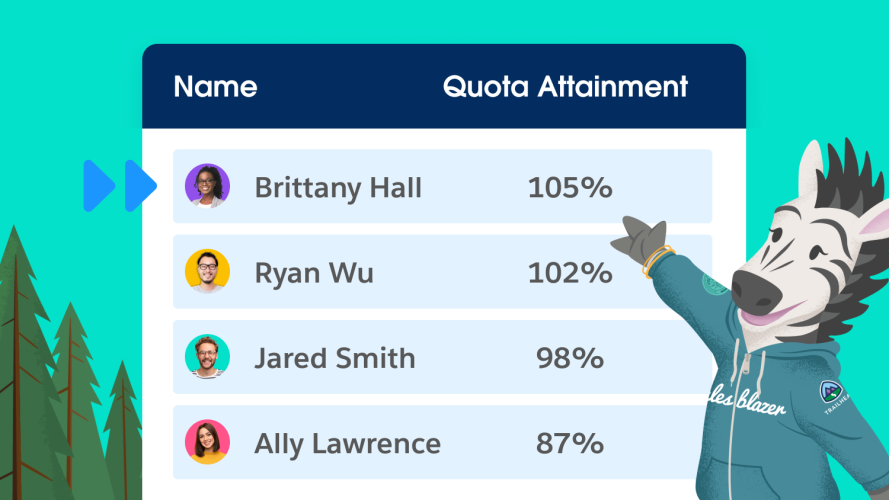Why a Sales Leaderboard Is the Key to Team Motivation — and How to Use it Effectively

Learn why the psychology of sales motivation makes the sales leaderboard an effective sales management tactic.
Watch any movie centered on sales professionals, and you’re likely to notice a recurring theme: competition. The sales reps in these films will stop at nothing to become the lone name atop a literal or figurative sales leaderboard – usually resorting to extreme tactics in order to be the best.
Of course, the degree of cutthroat competition in these films is sensationalized to give their stories higher stakes – like in the ‘90s classic “Glengarry Glen Ross,” which features a real estate firm where only the top deal-closers of the month will keep their jobs. But this overly dramatized theme is rooted in a real-world truth: A sales leaderboard is an incredibly effective motivator.
You’ll learn why in this blog post, as we explore the underlying psychology of sales motivation that makes the sales leaderboard a successful sales management tactic.
What you’ll learn:
- What is a sales leaderboard?
- Why do sales leaderboards work?
- 7 ways to get the most out of your sales leaderboard
Motivate your team with transparent incentive pay
Discover the power of automating commissions with Salesforce Spiff, and easily create incentive programs that scale.



What is a sales leaderboard?
A sales leaderboard is a tool that sales organizations use to track their teams’ or reps’ performance in a ranking-based system, much like a scorecard in golf or any other individual sport. It’s a popular form of gamification – a strategy for influencing and motivating different types of behaviors using common elements of gameplay. Think point scoring, rules of play, rewards, and more.
A typical sales leaderboard displays a ranking of performers based on a predetermined set of key metrics and individual targets – like quota attainment, sales activities, or new revenue generation. Sales reps receive points as they accomplish their various objectives and earn rewards for hitting certain milestones.
Sales leaderboards have been around for decades – even dating back to the pre-Internet days when they lived on chalkboards and poster paper in the office. But today, the increasing digitization of the workplace has led to sales leaderboards becoming powerful and multifaceted digital tools.
Why do sales leaderboards work?
Back when workplace gamification was still a relatively new concept, it had its share of detractors. Skeptics believed gamification to be more of a distraction than a motivator, or that it required too much work just to add a little fun to the workplace.
The results, however, speak for themselves. Leaderboards have been shown to improve sales performance:
- 72% of employees say that gamification motivates them to work harder.
- Workplace gamification can increase productivity by 50% and employee engagement by 60%.
- After implementing sales gamification tools, companies have experienced as much as a 45% increase in bottom-line sales margin.
Leaderboards aren’t just a way to spice up the day-to-day monotony of a sales job – they’re effective at driving both team and individual performance for reasons deeply rooted in behavioral science.
Here’s why gamification works so well for sales teams:
Gamification is motivating
Gamification is both an intrinsic and extrinsic motivator. An intrinsic motivator drives an individual to accomplish something because it’s personally rewarding; they want to succeed because doing so will make them feel satisfied, proud, and fulfilled.
Conversely, extrinsic motivators refer to external benefits a person expects to receive for succeeding at a given task. These may include monetary compensation, a shout out from a superior, or recognition from a peer.
Sales gamification works because it hinges on both forms of motivation. Reps want to succeed so they can win rewards and external recognition, of course – but they also desire the internal satisfaction they’ll get from seeing their name atop the leaderboard.
Sales leaderboards offer positive reinforcement
Anyone who works in sales is familiar with both positive reinforcement (rewarding good sales performance in order to make it continue) and negative reinforcement (punishing poor performance in order to make it stop).
There is a wealth of research in support of the claim that positive reinforcement motivates employees better than punishment. But many sales organizations fail to actually bake consistent positive reinforcement into the foundation of their sales strategy.
A sales leaderboard is one of the most potent sources of positive reinforcement because it’s immediate, consistent, and unbiased. A team member hits a target and sees a tangible result on the leaderboard.
Sales leaderboards feed the reward/compulsion loop
The reward/compulsion loop is a scientific theory that explains why we form many of our most persistent habits. It refers to a chain of actions that, when repeated, trigger a neurochemical “reward” – a release of dopamine that makes us feel a surge of happiness.
This cause-and-effect leads us to develop compulsions related to the actions that trigger neurochemical reward. It’s why you can’t stop playing your favorite phone game. The hits of dopamine the game provides have created an unconscious desire to keep playing it. Developers actually work compulsion loop mechanics into their game designs to keep players coming back.
The reward/compulsion loop explains why sales gamification has long-term, exponential benefits. When you first introduce gamification to your team, a sales rep might perform certain tasks – like calling an additional 10 prospects per day – because they’re consciously trying to get on top of the leaderboard.
As time goes on and that sales rep consistently earns rewards, their extra effort becomes less of a conscious decision and more of a habit. They associate calling more prospects with the pleasure they derive from earning rewards. It becomes part of their routine.
7 ways to get the most out of your sales leaderboard
Sales leaderboards can have a transformational impact on sales teams, motivating reps to reach their full potential and driving better business results – when implemented correctly. It’s not as simple as purchasing a gamification tool and introducing it to your teams. You must take a number of steps to adopt, manage, and iterate on your sales leaderboard program so it truly engages, satisfies, and motivates your reps.
Here are some best practices to abide by to ensure your sales leaderboard is successful.
1. Reward the right sales behaviors and activities
The goal of sales gamification is not only to motivate sales employees but also to actively help them do their jobs better. If you only reward big numerical goals, then you’re incentivizing success without nurturing the behaviors that create success.
For example: If you only reward results related to revenue created, opportunities won, and so on, your top performers will naturally be motivated to work even harder. But what about the rest of your team, particularly the younger reps who are learning what actions to take in order to achieve those big results? They will benefit from incentives that are tied to specific behaviors designed to help them improve, ultimately making them top performers.
Include behavioral KPIs into your leaderboard system so that reps earn points for doing the small things that lead to big results. For example, give outbound SDRs an opportunity to earn points for booking meetings, making cold calls, and sending personalized emails. Inbound SDRs can earn points for booking qualified meetings and responding to leads promptly. Reward these behaviors and you’ll watch as they become habits.
2. Make your leaderboard visible and accessible
Your leaderboard will only make an impact if it’s baked into your sales process. If it’s difficult to access – or something they have to remind themselves to look for – then your leaderboard won’t become the constant motivator you created it to be. A sales rep should never think: “Oh yeah, I wonder how I’m doing on that leaderboard thing.”
Avoid this problem by incorporating your leaderboard into your reps’ day-to-day workflows. Remember: It takes time for reps to start thinking of a leaderboard as a fundamental staple of the team’s strategy, rather than a fun but nonessential tool. Here are some easy steps to make your leaderboard a constant presence in your reps’ work days:
- Choose the right platform. Prioritize user experience when selecting a sales gamification software. Choose a platform that’s accessible from any device your reps use every day. Reps are far more likely to engage with a leaderboard they can view on a streamlined, visually compelling mobile app than one that’s only accessible through a bland or overly complex desktop app. Oh, and make sure it’s closely tied to your CRM, where you track all of your sales activities.
- Make it visible. Display your leaderboards on monitors in the office so that reps see them every time they get up from their desks. For remote sales reps, incorporate your new leaderboard into the channels, workflows, and software your team already uses – like Slack notifications, Salesforce dashboards, or email digests.
- Call out leaders often. Send regular emails to call out exemplary results and progress. If you send a weekly “leaderboard update” email on Monday mornings, reps will begin every work week by thinking of what they can do to climb the leaderboard. Pull up your leaderboard every chance you get. Review it during team meetings and one-on-ones alike. The more you bake your leaderboard into communications with your team, the more likely your team will be to keep it top of mind.
- Involve other departments. Make an effort to show off your sales leaderboards to other departments as well. Bring it up during all-hands meetings or send company-wide emails when someone achieves a big result. As more people show interest and curiosity in the leaderboard, reps will become that much more motivated to engage with it and strive to earn rewards.
3. Cater to all personality types
Knowing your sales team on a personal level is key to a successful sales leaderboard implementation. Remember that gamification motivates employees in several distinct ways – and likewise, employees will respond differently to motivation depending on their distinct personality types.
While no two sales employees are the same, you can likely group them into the following three categories. You’ll want to offer reinforcement that caters to each:
- Fun-seekers. These are the reps who find fun in healthy competition. They’re incredibly self-motivated and competitive, responding more to intrinsic motivators than any tangible rewards. Appeal to fun seekers by emphasizing the competitive aspects of the leaderboard. Create regular mini-games and time-sensitive contests, such as a competition to see who can book the most meetings in a given week.
- Socializers. These employees are motivated more by recognition and social clout. Socializers feel satisfied when they know others at the company can see what they’ve achieved. Cater to socializers by showing their success to the company. For example, award badges for accomplishing individual and team goals, or include a chart displaying the faces of top performers.
- Reward-chasers. These employees want to earn prizes for their accomplishments. Make sure to offer tangible rewards that reps actually want to earn – like gift cards or physical prizes (electronic devices, a fancy bottle of wine, useful office items) or bonus benefits (cash prizes, extra personal days). For major achievements, like generating the most sales in a calendar year, offer a more substantial prize like a large monetary bonus.
There will be some overlap across these groups, of course, but if you cater to all three of the above personality types, you’ll be sure to motivate the entirety of your sales force.
4. Don’t overcomplicate the rules and rewards system
Again, you want sales reps to want to engage with the leaderboard. If the rules are vague or confusing, your leaderboard will have the opposite effect. Reps won’t know how to win, so they’ll either ignore the leaderboard or become stressed and frustrated by it.
Create a rule system that is easy to understand and directly ties specific actions to specific rewards. Break up your points system into distinct categories based on weekly, monthly, quarterly, and yearly goals. Weekly goals will include the more activity-based KPIs we discussed earlier (cold calls made, meetings set, and so on), while longer-term goals focus more on the big-picture numbers (deals won, revenue generated, etc.)
Dividing leaderboard goals into distinct categories will help reps understand exactly how they can earn points in the short term while they remain aware of the big goals they’re working towards. This format will also help you sustain the motivational benefits of your leaderboard. Even if a rep has fallen behind in quarterly new sales, they start every week with a list of clear micro-goals they can accomplish to earn points right now.
5. Don’t over-reward for the bare minimum
Creating a reward system is a delicate balancing act. As we’ve discussed, you want to reward day-to-day behaviors that make up your sales strategy. But if you over-reward for these simple activities, like making a cold call or sending an email, you might actually demotivate top performers.
Establish a system that doesn’t ignore the small things, but rewards over-performance above all else. A sales rep who makes the most cold calls in a week should earn a small reward that motivates them to keep up the good work. But that reward should represent a small fraction of what a rep earns for closing a major deal or generating the most revenue in a month.
6. Automate when possible
If you want employees to embrace gamification, you need to make it easy for them to participate. When reps have to manually enter data to update their status on the leaderboard, you’re just giving them more work to do on top of selling activities. This isn’t exactly a recipe for increasing motivation and making sales more fun.
When adopting a sales gamification software, make sure you select one that you can integrate with your existing platforms and data sources. Work with your sales operations teams to connect your leaderboard to your CRM so that it updates stats in real-time. This will accomplish two important goals: You’ll prevent your reps from having to do unnecessary data entry while ensuring that your leaderboard stats are 100% accurate and up-to-date at all times.
Many sales gamification tools offer additional automation capabilities that can enhance the overall experience for your reps. You might set up daily kickoff messages that deploy to reps through your chosen communication platforms. Some tools offer even more creative features like automated “power hours,” where reps receive an alert at random times that signify the start of a time-sensitive challenge or mini-contest that gives them the chance to earn extra rewards.
7. Acknowledge progress as well as achievement
A sales leaderboard is about boosting motivation and excitement – it’s not about making reps feel like their worth is being reduced to a ranking or a number of points. That’s why it’s important to highlight progress, particularly the progress of those who aren’t consistently at the top of the board.
Continue to give high-performing sales reps the praise they deserve, but spend even more time encouraging and coaching those who haven’t cracked the top of the board yet. Study your leaderboard closely and zero in on those middle-of-the-pack performers. When a rep climbs from the bottom or middle of the leaderboard towards the top, it’s a sign of a healthy and effective gamification strategy.
Make these reps feel seen by highlighting important growth metrics on your sales leaderboard. If a rep closed more deals than they did the previous month, call out that improvement – especially if they’re not one of the big names sitting at the top of the board. You can even include a “most improved” category for important KPIs so that progress itself can earn reps more rewards.
Gather feedback and continuously tweak your leaderboard strategy
If you’re introducing a leaderboard for the first time, don’t expect to get it right on day one. Gamification is a process of learning, testing, and iterating. Gathering feedback is crucial to this process – not just in the early days of implementing a sales leaderboard, but continuously as your teams grow and change. Speak directly with participating reps and learn what they like about the leaderboard, what they don’t like, which rewards they aspire to earn, which they couldn’t care less about, and so on.
Attain quota faster and speed up sales ops
Learn how Sales Performance Management helps you connect customer data to sales planning and execution.




























